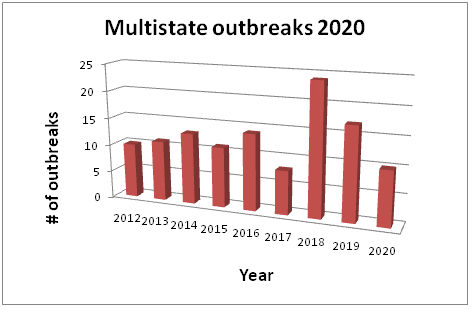Summary of multistate foodborne outbreaks in 2020

In 2020 we all focused on covid, including its impact on the food industry. However, foodborne outbreaks happened during the year. As in every year, the CDC reported the significant multistate outbreaks due to foodborne illnesses that occurred in 2020. The data for the last 12 years is shown in the graph below.

2020 had 10 major foodborne outbreaks reported by the CDC. This number is one of the lowest outbreak numbers, perhaps due to the focus on covid this year. The major outbreaks for the year are listed below:
April 22- Clover Sprouts- E. coli O103

The outbreak was traced to raw sprouts on sandwiches sold by Jimmy John’s restaurants. Fifty-one people infected with the outbreak strain of E. coli O103 were reported from 10 states. Three people were hospitalized. No deaths were reported. The outbreak investigation determined that a single lot of seeds was used to grow both the sprouts recalled by Chicago Indoor Garden and sprouts that were served at some Jimmy John’s locations. The same lot of seeds was also used to grow sprouts linked to an outbreak of the same strain of E. coli O103 infections in 2019.
June 9-Enoki Mushrooms – Listeria monocytogenes
The outbreak was traced to Enoki mushrooms from Korea sold by H&C Food Inc., Guan’s Mushroom Co., and Sun Hong Foods Inc. Mushrooms were recalled after tests showed the presence of Listeria monocytogenes in product samples. A total of 36 people infected with the outbreak strain of Listeria monocytogenes were reported from 17 states. 31 people were hospitalized. Four deaths were reported from California (2), Hawaii, and New Jersey. Six cases were pregnancy-associated, with two resulting in fetal loss. FDA collected samples of Enoki mushrooms for testing of import from Green Co. LTD of the Republic of Korea. On April 6, results showed that two samples were contaminated with the outbreak strain of Listeria monocytogenes. On April 7, the FDA placed Green Co. LTD on Import Alert, meaning their product was stopped at U.S. ports of entry. On March 18, the Korean Ministry of Food and Drug Safety published its investigation findings and its steps to prevent future illnesses. It found the presence of Listeria monocytogenes in Enoki mushrooms produced by two firms in the Republic of Korea.
September 24-Bagged Salad Mix – Cyclospora
The outbreak was traced to bagged salad mix containing iceberg lettuce, carrots, and red cabbage produced by Fresh Express. The company recalled specific Fresh Express brand and private label brand salad products made at its Streamwood, IL facility. A total of 701 people with laboratory-confirmed Cyclospora infections associated with this outbreak were reported from 14 states. Thirty-eight people were hospitalized. No deaths were reported.
October 8-Onions -Salmonella Newport
The outbreak was traced to onions from Thomson International Inc. The company was identified when the FDA and states reviewed records where ill people purchased or ate onions and foods containing onions. A total of 1,127 people infected with the outbreak strain of Salmonella Newport were reported from 48 states. Of 705 ill people with information available, 167 people were hospitalized. No deaths were reported. The traceback investigation identified Thomson International Inc. as the likely source. Red onions were implicated, but the company recalled its yellow and white onions as well since they were processed using the same equipment.
October 16-Peaches-Salmonella Enteritidis
The outbreak was traced to fresh, whole peaches from Prima Wawona or Wawona Packing Co. In several states, the FDA and regulatory officials collected records from grocery stores where ill people reported buying peaches. These records showed that loose and bagged peaches distributed by Wawona Packing Co. were sold at multiple grocery stores where sick people bought peaches.
A total of 101 people infected with the outbreak strain of Salmonella Enteritidis were reported from 17 states. Of 90 ill people with available information, 28 hospitalizations were reported. No deaths were reported. The outbreak due to peaches also caused an outbreak in Canada. On August 22, Prima Wawona recalled bagged, bulk and loose peaches supplied to retailers nationwide.
November 4-Wood Ear Mushrooms-Salmonella Stanley
The outbreak was traced to wood ear mushrooms distributed by Wismettac Asian Foods Inc. On September 23, Wismettac Asian Foods recalled dried fungus because of possible Salmonella contamination. The FDA and states conducted a traceback investigation from four restaurants with illness clusters to identify the source of the wood ear mushrooms eaten by ill people. On October 1, the California Department of Public Health identified the outbreak strain of Salmonella Stanley in recalled dried fungus samples. A total of 55 people infected with the outbreak strain of Salmonella Stanley were reported from 12 states. Of 48 ill people with information available, six hospitalizations were reported. No deaths were reported.
December 4-Deli Meats – Listeria monocytogenes
No specific deli meat was identified as the source of the outbreak. Of the ten people interviewed, all reported eating Italian-style deli meats, such as salami, mortadella, and prosciutto. They reported purchasing prepackaged deli meats and meats sliced at deli counters at various locations. A total of 11 people infected with the outbreak strain of Listeria monocytogenes have been reported from three states. All 11 ill people were hospitalized. One death was reported from Florida.
December 18-Unknown Source 1 – E. coli O157:H7
The FDA outbreak ended before enough information was available for investigators to identify the likely source of the outbreak. A total of 32 people infected with the outbreak strain of E. coli O157:H7 were reported from 12 states. 15 people were hospitalized, and one person developed hemolytic uremic syndrome (HUS), a type of kidney failure. One death was reported from Michigan. Some patients reported eating at the same restaurant, but investigators could not identify a common food. Other patients had not eaten at the restaurant but were sickened from the same strain of E. coli.
December 22-Unknown Source 2 – E. coli O157:H7
The CDC outbreak’s investigation showed that leafy greens were the likely source of the outbreak. According to the CDC and the FDA, investigators were unable to identify a specific type or brand since people reported eating various leafy greens and since different leafy greens are often grown, harvested, and processed together. A total of 40 people infected with the outbreak strain of E. coli O157:H7 were reported from 19 states. Twenty people were hospitalized, and 4 developed hemolytic uremic syndrome (HUS). No deaths were reported. According to the FDA, they identified several farms of interest, but no single ranch was found to be a common source of the leafy greens.
December 18-Unknown Source 3 – E. coli O157:H7
In the outbreak, a total of 18 people infected with the outbreak strain of E. coli O157:H7 were reported from 9 states. 13 people were interviewed about the food they had eaten before becoming ill. All of them reported eating or possibly eating various types of leafy greens, including romaine lettuce (9), spinach (9), and iceberg lettuce (7). 6 people were hospitalized, and no deaths were reported. Laboratory testing identified the outbreak strain in a sample of Tanimura & Antle romaine lettuce in a single-head package, which was recalled on November 6. However, investigators could not determine if any ill people in this outbreak got sick from eating the recalled product. No one specifically reported eating Tanimura & Antle romaine lettuce.
